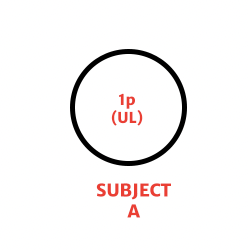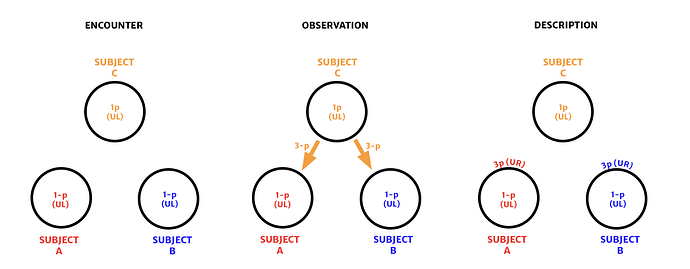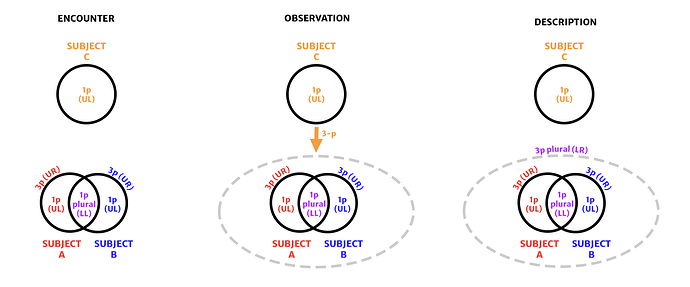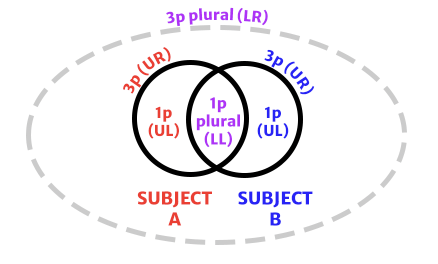It’s a great question, and it gets just a little bit geeky. I know you have many of these understandings baked into your question, but I will try to walk through it for newcomers.
In a sense, we could say that:
UL = 1st-person
LL = 2nd-person
UR = 3rd-person
LR = 3rd-person plural
However, we may already see an issue — the lower left isn’t actually 2nd person, but instead is more like “1st-person plural”. Which means the quadrants actually look more like this:
UL = 1st-person
LL = 1st-person plural
UR = 3rd-person
LR = 3rd-person plural
So what happened to 2nd person? Where is that 2nd person to be located in my own Four Quadrants?
Well the answer is, I do not possess a 2nd-person “inside of me”, it actually requires a second person (and their own UL, UR) that I am interacting with!
Which means that, when my 1st person UL is interacting with another 1st person UL, this generates a 2nd-person interaction. Our two UL quadrants, plus whatever LL contexts each of us may be working from, begin to merge, and a brand new LL intersubjective space emerges between us. We now have mutual understanding.
Now here’s where it gets a bit tricky — Ken does not equate the four quadrants with these perspectives. The upper-left isn’t actually “1st-person”, it is the interior of the individual. Rather, the perspectives are the ways that we can see and perceive realities in the other quadrants. If I want to know what’s going on in my own UL, I can see that in 1st-person. If I want to know what’s going on with my body, I can see that in 3rd-person. So the quadrants and the perspectives are related, but not the same.
So let’s make it even more tricky: each of these quadrants can be seen either in 1st-person, or in 3rd-person. For example, if we take a 1st-person view of the UL quadrant, we see things like “phenomenology” or “states of consciousness”. If we take a 3rd-person view of the UL quadrant, we see things like “structures of development” or “shadow”. (And in this case, “3rd-person” is somewhat literal — we can’t see our own interiors in 3rd-person, it actually requires another person’s 3rd-person to see those things.)
Which means, there is a 1st-person and 3rd-person view of every quadrant, which results in Ken Wilber’s 8 Zones, which describes the “inner” and “outer” of each quadrant.
Confusing enough?
Here is a piece of writing I recently produced that talks about what these 8 zones are, and why they matter:
These 8 Zones of Phenomenology describe how we perceive, disclose, and experience reality. It’s how we subjectively experience other subjects, objects, and occasions within our own Zone 1 phenomenological experience – the modes and methods we use to disclose reality in all its fundamental dimensions.
Think of it this way: we never see things or events as they truly are. Instead we can see only our own inner reconstruction or interpretation of those things and events – an interior experience of reality that is mediated by our senses, our nervous system, our psychological development, our shared meanings and contexts, and so forth. All of which determine how we create our inner mental maps of reality.
We can never fully or directly see something like a “justice system” or an “economic system”, for example. We can only see our own mental models of a justice and economic systems — mental models that may be more or less complex, more or less accurate, more or less biased, and so forth. But if we want to better understand these systems, there are specific practices or methodologies we can use to reveal those aspects of reality… and multiple other practices and methodologies to understand how those aspects, in turn, shape and are shaped by every other aspect of reality.
This is why these 8 zones are so important. They help us create the most complete mental maps and models as possible. These 8 zones describe how reality arises within our Zone 1 awareness — how our individual interiors are experiencing, reflecting, and intersecting with the rest of reality. It helps us think more clearly and more comprehensively about other subjects, other objects, other groups and systems, and even ourselves, all of which are arising within your own Zone 1 phenomenological space, right now.
So really, the “inside and outside of the LL”, for example, aren’t “2nd-person and 3rd-person”. It would be more accurate to say “From my own UL, I can take a 1st-person or 3rd-person perspective on 1st-person-plural (LL) realities.”
Or, if we are looking at the LR, “From my own UL, I can take a 1st-person or 3rd-person perspective on 3rd-person-plural realities.”
So why is the LL “1st-person plural” instead of “2nd-person”?
Well, because I don’t “have” a second person — you are that second person! So “second person” means, a second four-quadrant holon that I am interacting with. And when you and I engage in 2nd-person, sharing our own 1st-person UL experiences with each other, those two 1st-person UL experiences become a new 1st-person plural understanding. Because I am no longer alone with my own 1st-person experience — I now have another kind of 1st-person experience that is generated by our 2nd-person interactions.
Now, to the meat of your question — why is it also giving 2nd-person views of these quadrants? And the answer is, because we probably don’t have our prompting quite right 
Technically, a 2nd-person view of the lower left would be something like “what do I think you see when you look at 1st-person plural?”
Or, if I am looking at my UL in 2nd-person, “what do I think you are thinking about my thinking?”
So I am incapable of my own 2nd-person view, because I can never really know what you are thinking. All I can have is my own 1st-person sense of what you might be thinking. Which is why I can’t have a 2nd-person quadrant — that 2nd-person does not exist in my quadrants, it exists between my 4Q matrix and your 4Q matrix!
So I think what is happening here is, the AI is taking that 2nd-person more generally, to mean “what does 1st-person plural look like from our we-space?”
I personally think this is fine. It’s not technically correct, in terms of the integral math, but maybe we can think of these as “speculative zones” that can help stimulate our imagination or expand our thinking. Some might even consider expanding the 8 zones into 16 zones — four quadrants within four quadrants, which means I can enact your UL from my own UL, UR, LL, or LR. But you can probably see how that may get needlessly confusing, and I think the math might kind of break down at these scales.
This is my understanding anyway, I hope I explained it well enough!





